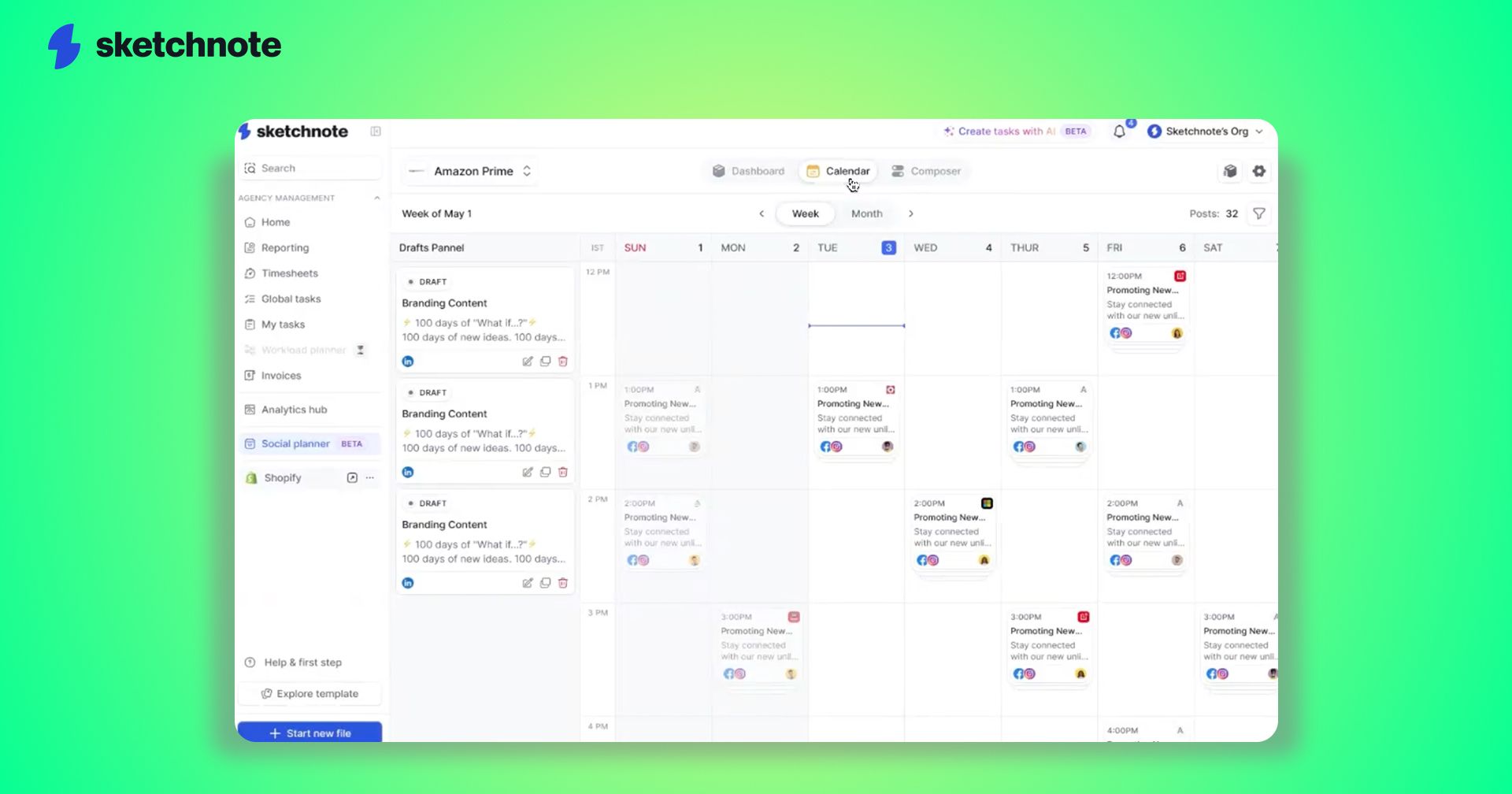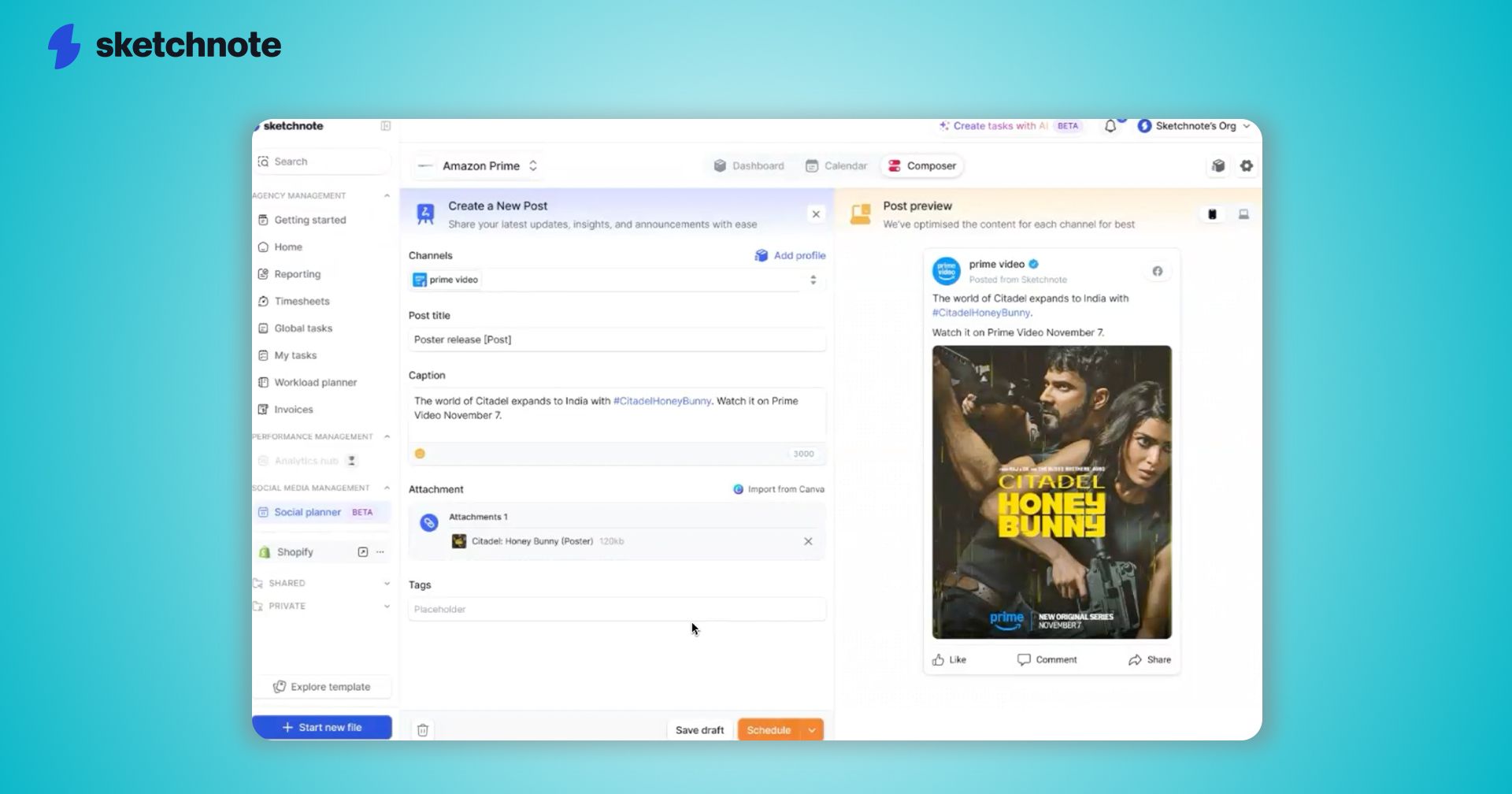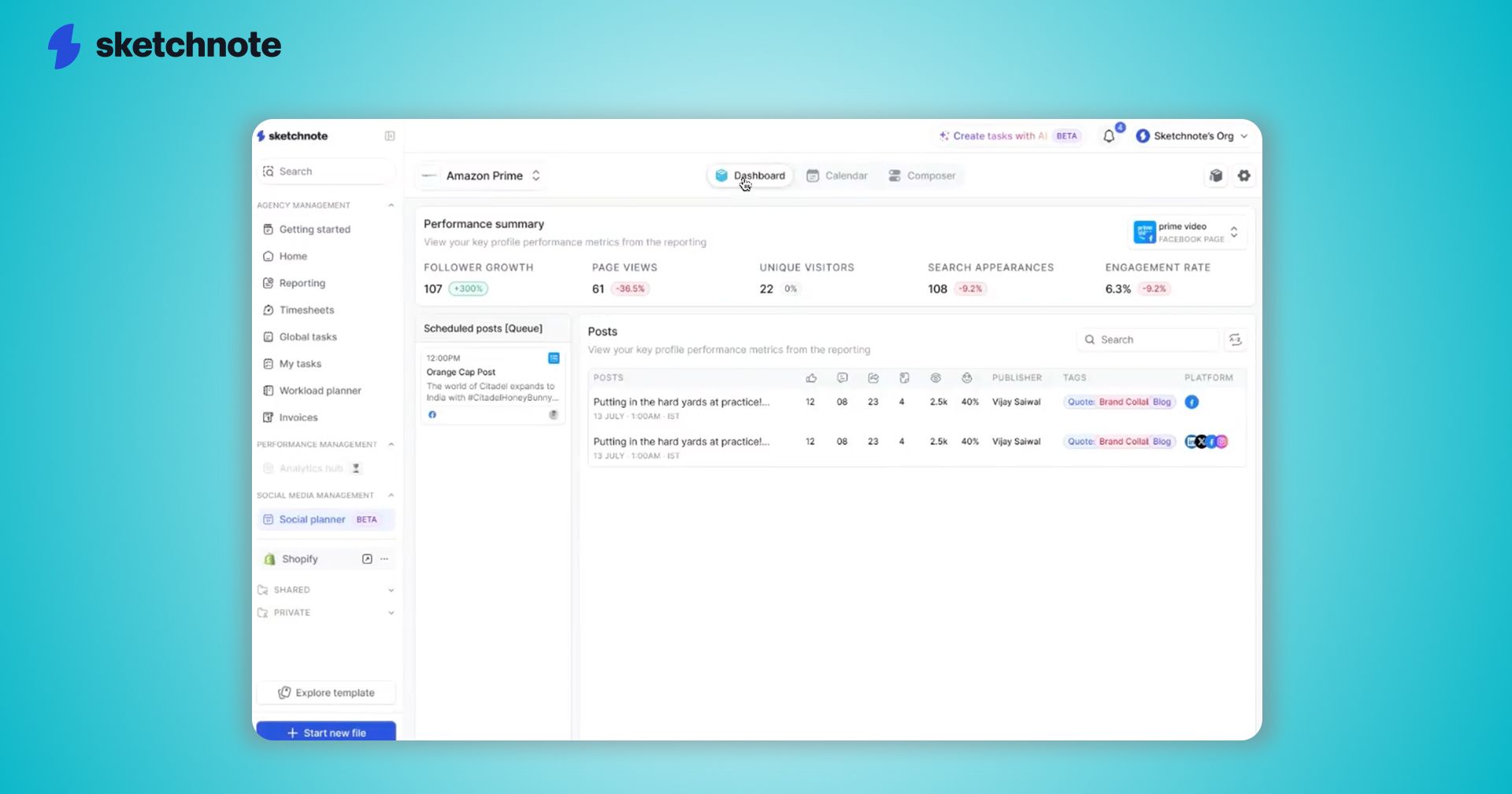An effective social media marketing calendar is more than just a schedule—it’s a powerful tool for strategically managing your brand’s presence, driving consistent engagement, and ensuring that each post aligns with your broader business goals. A well-structured social media plan is a smart, impactful addition to any marketing toolkit, helping you stay focused and amplify your results.
By mapping out your content in a thoughtful and organized way, you create a solid foundation that supports all aspects of your social media strategy. In this article, we’ll break down the essential steps to create a calendar that doesn’t just organize content but actively boosts your brand’s visibility, builds meaningful connections with your audience, and drives conversions. Let’s dive right in by first understanding why putting a Social calendar in place makes all the difference for your brand!
Understanding the Importance of a Social Media Marketing Calendar
A social media marketing calendar serves as a roadmap for your content strategy, allowing you to maintain consistency and relevance in your posts. By organizing your content in advance, you can ensure that you stay aligned with your business goals and enhance audience engagement. Planning ahead also enables you to capture key moments, adjust for seasonal trends, and keep your messaging consistent across all platforms.
Benefits of a Structured Approach
Along with providing clarity on your posting schedule, a structured approach enables you to allocate resources effectively. It helps you visualize your content mix, balancing promotional material with engaging posts.
For example, a retail brand could use its calendar to ensure it posts a mix of product highlights, customer testimonials, and seasonal promotions, ensuring variety while keeping the brand message cohesive. This approach also enhances your ability to track performance metrics, such as engagement rates and click-throughs, which can inform future campaigns and content strategies.
Impact on Audience Engagement
Implementing a well-organized social media calendar can lead to increased audience engagement. With a clear strategy in place, you’ll be able to post timely, relevant content that resonates with your followers, making it easier to connect on topics that matter to them.
To maximize engagement, focus on creating diverse content types that align with your audience’s preferences. On Sketchnote, for example, you can tag your social posts as Carousel, Reel, Static, etc., viewing these insights on your Dashboard to help you maintain an optimal content mix. Planning ahead also allows you to incorporate key events, industry trends, and seasonal topics, capturing attention when it matters most. This proactive approach not only boosts interactions but also fosters a loyal community around your brand.
Alignment with Business Goals
One of the primary advantages of a social media marketing calendar is that it allows you to align your content strategy with your overall business goals. By setting specific themes and objectives for your posts, you can work towards key performance indicators relevant to your brand's growth.
This alignment ensures that every piece of content serves a purpose, whether it's driving traffic to your website, boosting sales, or enhancing customer loyalty. By measuring your success against these predetermined benchmarks, you can fine-tune your strategies, ultimately contributing to a more effective and cohesive marketing approach.

Breaking Down the Process of Creating a Social Media Calendar
Some marketers view social media calendars as merely optional tools, but they serve as powerful frameworks that can drive structured engagement, enhance brand visibility, and align content with your overarching business goals. By systematically planning your social media efforts, you can maximize your impact and effectiveness, ensuring that each post resonates with your audience and contributes to measurable results.
Step 1: Define Clear Goals and Metrics
Before plunging into content creation, it's imperative to outline clear objectives and the metrics that will indicate success. Whether your aim is to increase brand awareness, drive website traffic, or enhance customer engagement, establishing specific, measurable goals will provide direction and focus for your calendar. This clarity will not only help you stay organized but will also facilitate easier assessment of your progress.
Step 2: Understand Your Audience
Goals can be better achieved when you have a deep understanding of your target audience. Identifying demographics, preferences, and behavior patterns will allow you to tailor your content to be more appealing and relevant. This insight ensures that every piece of content you create has the potential to connect and engage.
For example, if your audience research reveals that a large portion of your followers are young professionals interested in career growth, you could focus on LinkedIn for professional tips and Instagram for behind-the-scenes insights into your company culture. Process analysis through audience research reveals who your followers are and what they want from your brand. This knowledge not only informs your content strategy but also enables you to select the right platforms and posting times, optimizing engagement and interaction.
Step 3: Conduct a Content Audit
Target your efforts effectively by assessing your existing content. A content audit allows you to evaluate what has worked previously and what hasn’t, spotlighting successful formats, topics, and engagement levels. Understanding your content's performance ensures you build on your strengths while identifying opportunities for improvement.
Metrics from your content audit can shed light on past trends and audience preferences, highlighting areas in need of enhancement or reinvention. This comprehensive review equips you with valuable knowledge that shapes your future content strategy, enabling you to prioritize topics and formats that align with your audience’s interests while driving the desired business outcomes.
Building the Social Media Calendar
All successful social media strategies start with a well-structured calendar that keeps your content organized and impactful. A social media marketing calendar not only promotes consistency but also allows you to track performance against your business goals. By meticulously planning your posts, you ensure a steady flow of engagement, nurture audience relationships, and create opportunities for conversions. Building a calendar also enables you to stay ahead of trends and aligns your efforts with significant events or campaigns.
Step 4: Choose Your Social Media Platforms
Identifying the right social media platforms is vital to optimizing your reach and engagement. Each platform has its unique audience and content style, meaning you should select those that align best with your brand and objectives. Common choices include Facebook, Instagram, TikTok, and LinkedIn. Evaluate where your target audience spends their time and the type of content they engage with the most.
Step 5: Determine Content Types and Themes
Your content types and themes define the voice and personality of your social media presence. It's important to create a mix of content that resonates with your audience while staying true to your brand. Here is a table to help guide your content decisions:
| Content Type | Theme Example |
|---|---|
| Educational Posts | Industry Tips and Tricks |
| Promotional Content | Special Offers and Discounts |
| Engaging Content | Polls and Questions |
| Visual Content | Infographics and Images |
| User-Generated Content | Testimonials and Reviews |
Determine various types of content that can captivate your audience and convey your brand message. Consider using:
- Videos, to showcase products or behind-the-scenes footage
- Infographics, to present data in an engaging format
- Blog posts, to educate and inform your audience
- Podcasts, to provide value through conversations
- Live streams, for real-time engagement and interaction
After identifying effective content types and themes, you can tailor your posts to fit specific campaigns or events, maximizing your engagement potential.

Step 6: Schedule Content Consistently
The key to maintaining engagement is consistently scheduling your content. A regular posting schedule helps to keep your audience informed and eagerly anticipating your updates. Utilize social media management tools to automate posting, saving you time and enhancing your efficiency.
Social media success often hinges on consistency. By committing to a regular posting schedule, you reinforce your brand presence. A well-planned calendar allows you to analyze your posting frequency, monitor audience interaction, and adjust your strategy based on engagement insights. On Sketchnote's Social Media Planner, you can schedule posts across platforms like LinkedIn, Facebook, TikTok, and Instagram all on the same brand calendar. This includes adding captions, scheduling content, and easily viewing real-time analytics, such as post performance and account growth summary.
Here are some tips for effective scheduling:
- Identify peak engagement times for your audience
- Plan your posts in advance and use scheduling tools
- Factor in holidays, events, and relevant industry trends
- Rotate content types to maintain variety
- Review and tweak your schedule regularly based on performance metrics
Through consistent scheduling, you optimize your social media efforts for maximum impact.
Tips for Execution and Optimization
Many marketers find success when they focus on execution and ongoing optimization of their social media marketing calendar. To enhance your results, consider the following tips:
- Stick to your content schedule
- Engage with your audience regularly
- Analyze engagement metrics to inform future posts
- Test different formats and mediums
- Continuously refine your strategy based on insights
Knowing these best practices will help you improve your social media performance over time.

Step 7: Leverage Tools for Automation and Tracking
Optimization of your social media strategy is significantly enhanced by leveraging the right tools. Utilize social media management platforms to schedule posts, track engagement, and analyze performance metrics. Automation allows you to maintain a consistent presence, freeing you to focus on creating high-quality content. Popular tools like Hootsuite or Buffer can streamline your processes, making it easier to reach your audience effectively.
Step 8: Monitor and Adjust Based on Performance
Scheduling your content is just the beginning; ongoing monitoring and adjustments are crucial for long-term success. Take the time to analyze key performance indicators (KPIs) such as engagement rates, reach, and conversions. By regularly reviewing this data, you can identify what's working and what isn't, enabling you to make informed adjustments to your content strategy. On Sketchnote's Social Media Planner Dashboard, you can track this performance in real-time, with a breakdown of likes, saves, shares, and more across your social media platforms, giving you the insights needed to refine your strategy.
Automation tools can also assist in tracking these metrics, ensuring you stay ahead of trends and optimize your approach. By setting alerts for significant changes in engagement or reach, you can quickly pivot your content strategy when necessary. This proactive approach ensures that your social media efforts remain relevant and aligned with your business objectives.
Best Practices for Effective Social Media Calendars
For a social media marketing calendar to be truly effective, it should incorporate best practices that ensure your content is both relevant and timely. Establishing clear objectives, consistent themes, and regular review intervals can help maintain alignment with your business goals while maximizing audience engagement. By balancing planned campaigns with flexibility, you can adapt to real-time feedback and emerging trends, ultimately driving better results.
Batching Content Creation
By organizing your content creation process into batches, you can enhance efficiency and foster creativity. This approach allows you to focus on specific themes or campaigns, enabling a more streamlined workflow while also reducing the stress associated with last-minute content demands.
Adapting to Emerging Trends and Technologies
Above all, keeping your social media calendar flexible will allow you to adapt to emerging trends and technologies that can influence your audience's behavior. Being aware of new platforms, tools, and content types can enhance your reach and engagement, ensuring your strategy remains relevant.
To stay ahead in the rapidly changing digital landscape, continuously evaluate which trends your target audience is engaging with and how you can incorporate them into your strategy. Experimenting with new formats such as live videos or interactive content may capture your audience's attention and amplify your brand visibility, ultimately leading to increased engagement and conversions.
Advanced Techniques for Maximizing Engagement
Enhancing your engagement strategies can significantly influence your social media marketing outcomes. By incorporating advanced techniques, you can foster deeper connections with your audience. Consider the following approaches:
- Utilize data analytics to inform your content strategy.
- Experiment with different posting times and frequencies.
- Leverage storytelling to create more relatable and impactful posts.
- Implement A/B testing for your ad campaigns.
- Engage actively with your audience through comments and messages.
| Technique | Description |
|---|---|
| Data Analytics | Use insights to tailor your content to specific audience preferences. |
| Posting Times | Analyze when your followers are most active to optimize reach. |
| Storytelling | Create narratives that resonate emotionally with your audience. |
| A/B Testing | Determine which ads perform better through targeted variations. |
| Active Engagement | Foster community by responding to comments and queries promptly. |
Personalization and Tailored Content
On your journey to enhancing engagement, personalizing your content is vital. By aligning your posts with the interests and behaviors of your audience, you create content that feels relevant and impactful. Tailored messages resonate more, leading to higher engagement rates and enhancing brand loyalty.
Interactive Content Strategies
With the growing expectation for dynamic experiences, incorporating interactive content into your strategy can significantly boost engagement. Polls, quizzes, and interactive videos invite participation, encouraging your audience to interact directly with your brand. This not only makes your content more enjoyable but also fosters a sense of community.
Even small interactive elements can have a substantial impact on engagement levels. Utilizing tools like Instagram Stories for polls or hosting live Q&As can create an ongoing dialogue with your audience. This real-time interaction nurtures relationships, making your brand not just a content provider but a trusted partner in your audience’s journey.
Community Building and User-Generated Content
Tailored efforts towards community building can powerfully enhance your brand’s presence. User-generated content (UGC) not only provides social proof but also encourages your audience to feel invested in your brand. By showcasing UGC, you let your followers feel valued and appreciated, which in turn fosters loyalty.
Content creation is not solely your responsibility; empowering your audience to share their experiences can lead to a dynamic community. Encourage your followers to share photos or stories related to your products. By promoting this type of engagement, you tap into authenticity, making your marketing campaign more relatable and effective.
Collaborating with Stakeholders
Keep in mind that effective collaboration with stakeholders can significantly enhance the success of your social media marketing calendar. Engaging both internal teams and external influencers helps ensure your content resonates well with your audience while achieving aligned marketing objectives. Your team’s active participation in this collaborative process will result in more innovative content creation and improved campaign effectiveness.
Aligning with Internal Teams
Against a backdrop of diverse departmental goals, aligning with your internal teams is important for a cohesive social media strategy. Working closely with departments such as sales, customer support, and product development allows you to gain valuable insights that shape your content. This ensures that your messaging is not only consistent but also relevant and timely, responding to both internal initiatives and market demands. On Sketchnote, you can collaborate seamlessly with your team on projects, track progress, monitor time spent on tasks, handle approvals, and more—making it easier to stay aligned and work together efficiently across all aspects of your content planning.
Involving External Influencers
Collaborating with external influencers can amplify your brand's reach and credibility. By involving these individuals, you can tap into their established audiences, creating a win-win scenario. This partnership enriches your content, makes it more engaging, and positions your brand within broader conversations, ultimately leading to increased brand awareness and potential conversions.
Even a well-chosen influencer can bring a fresh perspective to your marketing efforts, making your content more relatable and appealing to your target audience. Consider selecting influencers who share values that align with your brand and possess a genuine connection with your audience. This not only enhances authenticity but also promotes more effective engagement, allowing you to leverage their insights to refine your messaging and content strategies further.
Managing Communication Efficiently
Internal communication processes should be streamlined to ensure everyone is on the same page regarding your social media calendar. Establishing regular check-ins or using collaborative tools can facilitate transparent discussions, making it easier to share updates and receive feedback from all stakeholders involved.
Another approach is to utilize project management software that centralizes communication and documentation. This can drastically reduce miscommunication and ensure that all teams have access to the latest updates on content deadlines and strategic shifts. Efficient communication channels create a more collaborative environment, ultimately leading to better results across your social media initiatives.
Legal and Ethical Considerations
After developing your social media marketing calendar, it is vital to consider the legal and ethical implications surrounding your content. Adhering to these standards ensures not only compliance with regulations but also fosters trust and loyalty among your audience. Your brand's reputation hinges on ethical practices and legal adherence, which can significantly influence engagement and conversion rates.
Understanding Platform Guidelines
The guidelines set forth by each social media platform play a vital role in shaping your content strategy. These rules dictate what types of posts are permissible and detail best practices for promoting your brand while avoiding penalties or account suspensions.
Compliance with Advertising Standards
To effectively navigate the landscape of social media marketing, you need to ensure your campaigns align with advertising standards. This involves understanding the regulations specific to your industry and region, and tailoring your strategies accordingly to uphold integrity and credibility.
Compliance with these advertising standards is vital for avoiding potential legal repercussions and maintaining a positive image for your brand. Familiarize yourself with guidelines from organizations such as the Federal Trade Commission (FTC) or the Advertising Standards Authority (ASA) in your area. Adhering to truth-in-advertising laws, including accurate representation of products and disclosure of partnerships, not only protects your business but also enhances consumer trust, ultimately driving higher engagement and conversions.
Respecting User Privacy
By prioritizing user privacy in your social media marketing efforts, you build stronger relationships with your audience. This entails transparent data collection practices and respecting users' preferences regarding their information.
Ethical handling of user data is paramount in fostering a trustworthy brand identity. Ensure you comply with regulations like the General Data Protection Regulation (GDPR) and the California Consumer Privacy Act (CCPA). Providing clear privacy policies, obtaining explicit consent for data usage, and enabling users to control their information will not only keep you compliant but also enhance user engagement, leading to increased brand loyalty and long-term success. Your audience will appreciate your commitment to their privacy, which can translate into higher conversion rates and a better overall brand image.
Cultural Sensitivity in Social Media Marketing
Your approach to social media marketing must prioritize cultural sensitivity to build authentic connections with diverse audiences. By understanding and respecting cultural nuances, you can create content that resonates positively, avoids unnecessary backlash, and enhances brand loyalty. Industry insights indicate that culturally tailored campaigns see higher engagement rates and stronger customer trust, making it vital to incorporate these aspects into your marketing calendar.
Recognizing Diverse Audiences
In the context of globalization, businesses increasingly encounter audiences with varied cultural backgrounds. Acknowledging this diversity can significantly impact how your brand is perceived and engaged with on social media.
Crafting Inclusive Campaigns
Against the tendency to generalize, it's important to craft campaigns that genuinely reflect the breadth of your audience's experiences. Tailoring your message to include diverse perspectives not only enhances engagement but also fosters a sense of belonging among your followers.
Crafting inclusive campaigns involves conducting thorough research on your audience demographics and their cultural values. Utilize this knowledge to create targeted content that highlights relevant themes and stories. Collaborating with diverse creators can also help bring authentic voices to your campaigns, ensuring representation while enriching your overall brand narrative.
Avoiding Cultural Missteps
Beneath the surface of diverse landscapes, it is vital to avoid cultural missteps that can alienate potential consumers. Sensitivity in communication and visual representation ensures you don't inadvertently offend or misconstrue a cultural reference.
Audiences are more vigilant than ever regarding cultural appropriation and insensitivity. By taking the time to understand the customs, values, and historical contexts of the communities you engage with, you can mitigate risks associated with misrepresentation. Social listening tools can help monitor conversations and trends, giving you real-time insights into how different communities perceive your content. This effort not only safeguards your brand's reputation but also strengthens the relationship between your business and its audience, fostering an environment of mutual respect and appreciation.
Evaluating the Success of Your Social Media Calendar
Once again, evaluating the success of your social media marketing calendar is essential for understanding its impact on your overall strategy. By measuring the effectiveness of your content, you can identify what resonates with your audience and refine your approach to enhance engagement and conversions in future campaigns. Regular evaluation helps ensure that your social media efforts remain aligned with your evolving business goals.
Setting Review Periods
Evaluating your calendar's performance begins with establishing regular review periods. Setting specific intervals—whether weekly, monthly, or quarterly—allows you to consistently assess your tactics and make informed adjustments, keeping your strategy responsive to audience feedback and trends.

Analyzing Performance Data
Your analysis should leverage performance data to gain insights into what works and what doesn't. Analyzing metrics such as likes, shares, comments, and click-through rates offers a comprehensive view of your audience engagement and content effectiveness. This data-driven approach allows you to refine your strategies for improved results.
A thorough analysis involves diving deeper into key performance indicators (KPIs) that directly relate to your business objectives. Look at engagement rates across different platforms, conversion metrics stemming from social campaigns, and audience growth trends. This statistical insight will provide a clearer picture of your content's impact and help you align future posts with your audience's preferences and your business goals.
Gathering Feedback from Target Audiences
Setting up mechanisms for gathering feedback from your target audiences can significantly enhance your content strategy. Use surveys, polls, or direct questions on social media to solicit input from your followers, allowing you to gain first-hand insights into their preferences and perceptions.
Further, utilizing this feedback helps you tailor your content more effectively. By understanding what resonates with your audience, you can adjust your messaging, content formats, and delivery timings. This direct line to audience sentiment reinforces your commitment to customer engagement, ensuring that your social media presence remains relevant and appealing.
Tools and Resources for Social Media Management
To successfully navigate the dynamic landscape of social media marketing, leveraging the right tools and resources can significantly enhance your strategy. A well-structured approach not only saves time but also ensures that your content aligns with your brand's goals, ultimately driving engagement and conversions. By utilizing these tools, you can stay organized, track your performance, and make data-driven decisions to optimize your campaigns effectively.
Best Social Media Management Platforms
Along with refining your strategies, using a dedicated social media management platform can streamline your workflow. Platforms like Sketchnote make it easier to schedule posts, analyze engagement metrics, and manage multiple accounts—all from a centralized dashboard. This allows you to focus on creating impactful content that resonates with your audience while optimizing your social media efforts for greater efficiency and results.
Educational Resources for Continuous Learning
An effective marketer never stops learning. Accessing educational resources can keep you updated on the latest trends and best practices in social media marketing. Engaging with courses, webinars, and blogs can offer insights that refine your approach and enhance your skills, equipping you to drive better results for your brand.
Resources abound for you to develop your expertise in social media marketing. Many platforms offer free or affordable courses focusing on specific topics, such as analytics or content creation strategies. You can also find numerous blogs and podcasts that share valuable tips from industry experts and case studies that provide real-world applications of theoretical knowledge, helping you adapt your strategies effectively.
Automation Tools for Efficiency
Learning to use automation tools can drastically improve your efficiency in managing social media channels. These tools allow you to schedule posts in advance, engage with your audience promptly, and analyze performance metrics—all of which contribute to a more organized and effective marketing approach.
Social media automation tools not only save you time but also help maintain consistent engagement with your audience. By automating routine tasks, such as post scheduling and reporting, you can allocate more resources toward crafting creative content and strategizing future campaigns. Many automation platforms also provide analytics dashboards, enabling you to track the effectiveness of your posts and adjust your strategies accordingly for optimal results.
Future Trends in Social Media Marketing
Unlike past years when platforms remained static, the landscape of social media marketing is rapidly evolving. Staying ahead involves understanding not only current trends but also anticipating future shifts. An effective strategy will require you to adapt your calendar to incorporate these upcoming changes, ensuring your brand remains relevant and engaging to your audience.
Predictions for Platform Evolution
Before exploring strategies, consider how popular platforms may evolve in functionality and audience engagement. The rise of video content and ephemeral posts indicates a shift toward faster, more engaging formats. As consumer preferences continue to change, you’ll need to adjust your marketing calendar to align with these platform developments.
Emerging Technologies Impacting Marketing
Beneath the surface of traditional post-and-engage tactics, emerging technologies like AI and augmented reality are reshaping how you interact with your audience. Leveraging these tools can enhance user experience and allow you to create more personalized content, which studies show improves customer retention and brand loyalty.
Marketing your brand effectively now requires embracing advancements in technology. For instance, AI-driven analytics can help you refine your strategies based on real-time data, enabling a more tailored approach to your audience. Additionally, integrating augmented reality into your campaigns can provide immersive experiences, capturing attention and enhancing engagement, ultimately driving higher conversion rates.
Sustainability in Social Media Approaches
An increasing focus on sustainability is prompting brands to reflect these values in their social media strategies. As consumers become more environmentally conscious, aligning your content with sustainable practices can bolster your brand image and cultivate loyalty, ensuring that your messages resonate with your audience's values.
In addition to promoting sustainable practices, your social media content can highlight corporate responsibility initiatives, such as eco-friendly product lines or partnerships with environmental organizations. By incorporating these elements into your marketing calendar, you reinforce your brand as one that prioritizes social and environmental issues, which research indicates can significantly enhance customer engagement and brand trust.

Analysis of Successful Campaigns
With a careful examination of successful social media campaigns, you can identify the critical elements that led to their effectiveness. Brands that prioritize consistency and strategic alignment with business goals tend to outperform competitors in audience engagement and conversion rates.
Strategies that Yielded Results
Social media strategies that consistently deliver results are rooted in understanding your audience and utilizing data-driven insights. Crafting a content calendar allows you to create tailored messages that resonate with your followers, reinforcing your brand identity.
That said, it’s also important to keep your content fresh and relevant. Engaging with your audience through polls, questions, and timely topics can significantly increase interaction. Utilize analytics to assess what works best, allowing you to refine your approach continuously.
Final Words
By implementing a well-structured social media marketing calendar, you set the stage for results that align with your business goals. Strategic planning and consistent engagement empower your brand to connect meaningfully with your audience. With a thoughtful approach and actionable steps, you can enhance customer interactions, increase brand visibility, and drive conversions. Embrace the process, and let your calendar be the catalyst for your continued success. Happy posting and growing!



